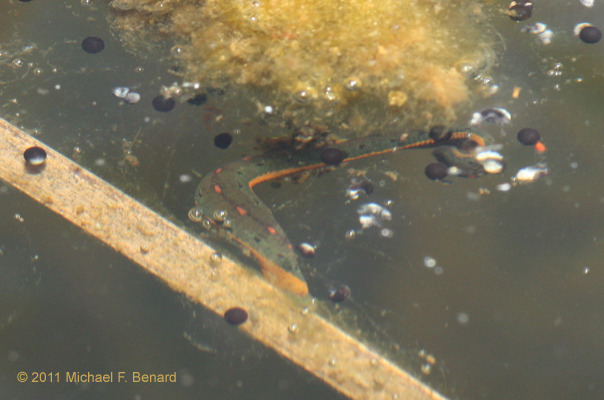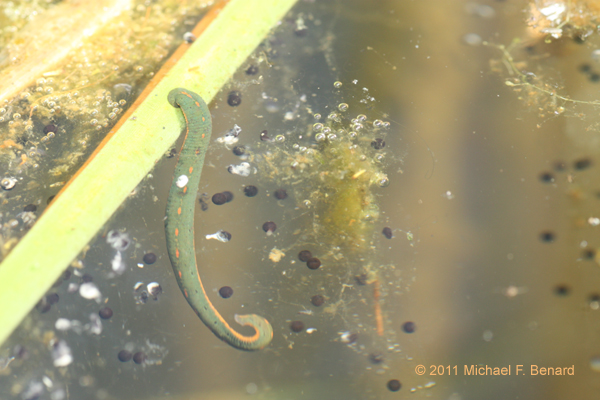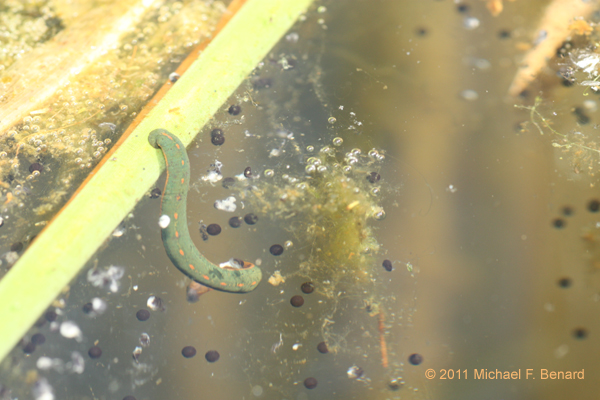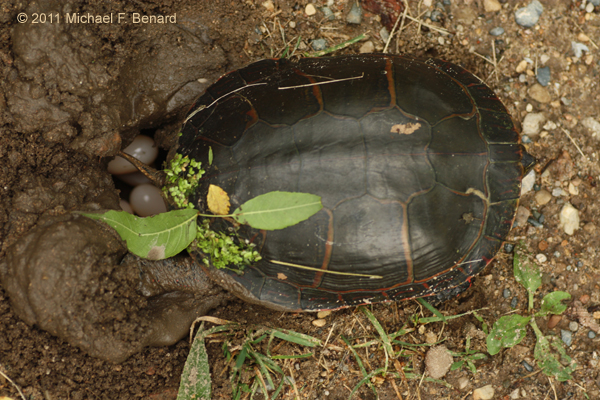mikebenard
New member
- Joined
- May 7, 2007
- Messages
- 49
- Reaction score
- 13
- Points
- 0
- Country
- United States
- Display Name
- Mike Benard
It has been quite a while since I've posted here due to lots of other commitments, but I had the good fortune to meet John Clare over the summer, and I've got a few observations that might be of interest to members of this board.
The photos below are from this season’s fieldwork that mostly occurred in Michigan. These photos span March 2011 to August 2011. The narrative bounces back and forth between different times of the year. Most of the photos were taken opportunistically while conducting a few different research projects on the ecology and evolution of amphibians.
The first couple photos were taken in June. I was taking a break from regular fieldwork by wading around in a pond at night. One of my favorite things to do is wade around in wetlands at night. All sorts of interesting animals that are hard to observe during the day come up to the surface at night.
One of my favorite amphibians to observe at night are Ambystoma larvae. They often don’t seem to mind dim light from a headlamp, and will cruise around eating invertebrates while you watch. However, you have to sit still long enough for them to think you are a big log.
One of the interesting things observed this year was that plenty of animals were covered with leeches. This first A. laterale larvae had a leech attached to the side of its face; it had also had the gills on the left side of its head missing. Were the gills chewed off by a dragonfly larvae? By another Ambystoma larvae? Who knows, but it is still a tough break for this individual.

Here’s another individual with both sets of gills intact, but a leech hanging on one of the gills. Roughly one in ten of the Ambystoma larvae I observed had leeches on them.

Many interesting invertebrates also can be found floating at the surface, hunting for food. This is a water scavenger beetle (Hydrophillidae). These larvae can eat small amphibian larvae. However, this individual was the perfect bite size for tiger salamander larvae.

Diving beetle (Dytiscidae) larvae in the genus Acilius. These primarily prey upon zooplankton. Ambystoma probably also enjoy eating these smaller Acilius too.

There were quite a few male green frogs calling.

This grey treefrog starting calling in the water, then climbed up on a log tocontinue to call.


So for more of the nightmares of the aquatic world – at least, a nightmare if you are an egg. One of the student researchers working for me this summer was conducting an independent study on green frog oviposition site selection. This required him to regularly search ponds for fresh green frog egg masses. One day he reported finding a large bullfrog egg mass that was covered in leeches. We hurried over to check it out!
Two Leeches Together:

One Leech with mouth open seeking another egg to eat:

These are American medicinal leeches (Macrobdella decora), although we normally just call them fire-belly leeches. These are voracious consumers of amphibian eggs. We also occasionally see them in March devouring wood frog eggs. When densities of these leeches get high enough, they can decimate a bullfrog egg mass with thousands of eggs in a few days. The photo series below shows one of the leeches extending its body to wrap around an egg. The gaping mouth can also bee seen on the end of the leech.





Here is another series of a different individual leech reaching out to consume more eggs:




Of course, the leeches don’t always get all of the eggs in a pond. Here’s a couple photos taken a few weeks later of some ranid tadpoles that did successfully hatch, and escaped predation by leeches.
Green Frog (Rana clamitans) tadpole:

Bullfrog (Rana catesbeiana) tadpole:

OK, now we’ll jump back in time, from mid-summer back to the end of winter, with a few observations from the March/April breeding season. This is a great time of year, with a wide range of frogs and salamanders on the move and many breeding.
First up are two female wood frogs (Rana sylvatica); one is brown and the other is red. These frogs are an example of the interesting within-population color polymorphism of wood frogs. I’ve been curious about whether the red and brown forms are due to genetics or environment.

Next is a male tiger salamander cruising around in a breeding pond. In previous years I’ve seen tiger salamanders and other ambystomatids assaulted by wood frogs.
<A href=" http://www.youtube.com/watch?v=DwaH6oZFs5s"> assaulted by wood frogs.</A>
No such observations in 2011.

Blue-spotted salamander (Ambystoma laterale) or possible hybrid:

Spotted salamander (Ambystoma maculatum):


A few four-toed salamanders (Hemidactylium scutatum) are regularly seen near the ponds in March/April just as the ice is melting.


OK, enough of the earlier spring season and back to the summer field season.
One day this adult blue racer showed up trying to get into the garage of our research station. One of the student researchers moved the racer away from the building while a few others enjoyed the scene.


We also saw this mourning dove with a chick one day.

Last photo – this female painted turtle was laying eggs about 10 meters from my front door.

The photos below are from this season’s fieldwork that mostly occurred in Michigan. These photos span March 2011 to August 2011. The narrative bounces back and forth between different times of the year. Most of the photos were taken opportunistically while conducting a few different research projects on the ecology and evolution of amphibians.
The first couple photos were taken in June. I was taking a break from regular fieldwork by wading around in a pond at night. One of my favorite things to do is wade around in wetlands at night. All sorts of interesting animals that are hard to observe during the day come up to the surface at night.
One of my favorite amphibians to observe at night are Ambystoma larvae. They often don’t seem to mind dim light from a headlamp, and will cruise around eating invertebrates while you watch. However, you have to sit still long enough for them to think you are a big log.
One of the interesting things observed this year was that plenty of animals were covered with leeches. This first A. laterale larvae had a leech attached to the side of its face; it had also had the gills on the left side of its head missing. Were the gills chewed off by a dragonfly larvae? By another Ambystoma larvae? Who knows, but it is still a tough break for this individual.

Here’s another individual with both sets of gills intact, but a leech hanging on one of the gills. Roughly one in ten of the Ambystoma larvae I observed had leeches on them.

Many interesting invertebrates also can be found floating at the surface, hunting for food. This is a water scavenger beetle (Hydrophillidae). These larvae can eat small amphibian larvae. However, this individual was the perfect bite size for tiger salamander larvae.

Diving beetle (Dytiscidae) larvae in the genus Acilius. These primarily prey upon zooplankton. Ambystoma probably also enjoy eating these smaller Acilius too.

There were quite a few male green frogs calling.

This grey treefrog starting calling in the water, then climbed up on a log tocontinue to call.


So for more of the nightmares of the aquatic world – at least, a nightmare if you are an egg. One of the student researchers working for me this summer was conducting an independent study on green frog oviposition site selection. This required him to regularly search ponds for fresh green frog egg masses. One day he reported finding a large bullfrog egg mass that was covered in leeches. We hurried over to check it out!
Two Leeches Together:

One Leech with mouth open seeking another egg to eat:

These are American medicinal leeches (Macrobdella decora), although we normally just call them fire-belly leeches. These are voracious consumers of amphibian eggs. We also occasionally see them in March devouring wood frog eggs. When densities of these leeches get high enough, they can decimate a bullfrog egg mass with thousands of eggs in a few days. The photo series below shows one of the leeches extending its body to wrap around an egg. The gaping mouth can also bee seen on the end of the leech.





Here is another series of a different individual leech reaching out to consume more eggs:




Of course, the leeches don’t always get all of the eggs in a pond. Here’s a couple photos taken a few weeks later of some ranid tadpoles that did successfully hatch, and escaped predation by leeches.
Green Frog (Rana clamitans) tadpole:

Bullfrog (Rana catesbeiana) tadpole:

OK, now we’ll jump back in time, from mid-summer back to the end of winter, with a few observations from the March/April breeding season. This is a great time of year, with a wide range of frogs and salamanders on the move and many breeding.
First up are two female wood frogs (Rana sylvatica); one is brown and the other is red. These frogs are an example of the interesting within-population color polymorphism of wood frogs. I’ve been curious about whether the red and brown forms are due to genetics or environment.

Next is a male tiger salamander cruising around in a breeding pond. In previous years I’ve seen tiger salamanders and other ambystomatids assaulted by wood frogs.
<A href=" http://www.youtube.com/watch?v=DwaH6oZFs5s"> assaulted by wood frogs.</A>
No such observations in 2011.

Blue-spotted salamander (Ambystoma laterale) or possible hybrid:

Spotted salamander (Ambystoma maculatum):


A few four-toed salamanders (Hemidactylium scutatum) are regularly seen near the ponds in March/April just as the ice is melting.


OK, enough of the earlier spring season and back to the summer field season.
One day this adult blue racer showed up trying to get into the garage of our research station. One of the student researchers moved the racer away from the building while a few others enjoyed the scene.


We also saw this mourning dove with a chick one day.

Last photo – this female painted turtle was laying eggs about 10 meters from my front door.

